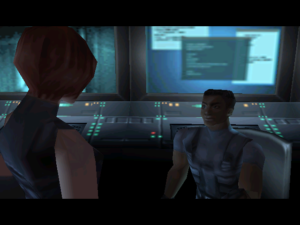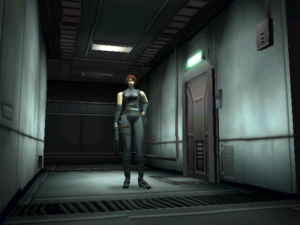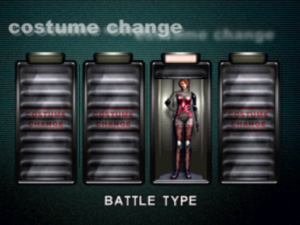Caillois and the Road to Dino 4D
Before I put on a trenchcoat and fight some conspiracies, another interlude. Today I was in the vicinity of one of those motion simulator rides — that is, a movie screen and chairs that tilt up and down and sometimes things that blow air at you to simulate the rushing of wind. I had never tried such a thing before, and since they had a dinosaur-themed show, I felt that I had to try it in the name of further research. Emily Short posted about her experiences with rides of this sort at a theme park a few months back, but I get the impression that the theme-park strain of ride is higher-budget than the urban tourist-trap variety.
I actually experienced two “rides” using the same hardware. The first was an exaggerated log ride down a river in the mountains, essentially just a virtualized roller coaster; the second was more narrative, sending the audience on a perilous journey to Dino Island to airlift out the last remaining male tyrannosaurus before the island explodes. (This is definitely a medium aimed at children, and so, to comply with current mores, dinosaurs aren’t things to be shot like they were in Dino Crisis. After all, if we can keep gun violence out of children’s media, kids will learn that it’s a grown-up thing, to be looked forward to, just like binge drinking.) I honestly thought the straightforwardness of the log ride worked better: it let me experience the physical sensations without worrying about why things were happening or what it meant for the mission. Both were preceded by a cheesy mock-serious intro that put me in mind of Saturday morning TV. That’s about what I was expecting from the experience, I suppose: cheesiness and gimmickry. And at some point, I realized: These rides are a close relative of the 90s FMV game.
Seriously, both forms are essentially movies made novel by technological gimmickry (which, in turn, is expected to make the audience forgiving). Once we recognize this kinship, it’s reasonable to speculate that the producers recognized it first — that the motion simulation ride and the FMV game were regarded by their makers as filling the same niche, despite the gamers’ expectation that the latter fill a quite different niche, that of game. Which raises interesting questions: Did “siliwood” even understand that games play a different role in the gamer’s life than theme park rides? Do the captains of the industry understand it even now? And if they don’t… are they wrong?
To change tracks abruptly, I recently read Man, Play, and Games by Roger Caillois. I honestly don’t recommend it — although it’s part of the canon of ludology, it doesn’t really have much to say that’s relevant to the subject. Apart from an appendix about lottery systems, it mainly just makes unsupported generalizations about games, which are then used as a launching point for the real subject, unsupported generalizations about society. Some of the assertions are even blatantly false — for example, when he says that games heavily based on agon (struggle) and alea (chance) never have, and indeed in principle cannot have, a strong element of mimicry 1Some translations apparently use “mimesis” here. It’s unclear to me which word was used in the original French, given that Caillois deliberately avoids taking his terms from just one language. I use “mimcry” here because “mimesis” has other connotations in the IF community. (assuming alternate roles). We can’t blame him for not predicting Dungeons & Dragons, but it seems bone-headed of him to call it impossible, especially since a little implicit mimicry had been part of hobby wargaming for decades.
The main thing of value Caillois provides us with is his conception of, and terminology for, the principles that, according to him, underlie all play. There are four, three of which we’ve just seen: agon, alea, and mimicry. The fourth is ilinx, or vertigo: pleasure in physical loss of control. It’s at this point that the student of games balks, but in fact he’s not really talking about games here. He’s talking about play, a much broader category, stretching from the undirected frolicking of children to crossword puzzles to dancing — even, if you want to really stretch it (and Caillois does), to theatrical productions. Ilinx is present in the play of children as they swing on swings or slide on slides or even just spin around and get dizzy; it plays a lesser role in the play of grown-ups, but is claimed to be behind the appeal of alcohol and other drugs. But there’s one place where ilinx is available to people of all ages: carnival rides.
Now, Caillois makes much of a supposed alliance of agon and alea, hostile to the mimicry/ilinx axis. I’ve already expressed some skepticism about this schema, but looking at the history of gimmick movies makes it temptingly plausible. For what is an interactive movie but a movie with elements of agon? And what is a motion simulator ride but a movie with elements of ilinx? To the extent that they fill the same niche — which they probably do in the ecology of Hollywood, if not in our hearts — the latter has supplanted the former. To Caillois, that’s a step backward. And for once, I’m inclined to agree with him. The interactive movie was an overhyped dumbing-down of gaming, an attempt to make the unruly new artform fit better into established production pipelines, but I can’t help but feel that it was also an experiment that never fulfilled its potential. The simulated motion ride bears a similar relationship to the actual motion ride (that is, the roller coaster and its ilk): it’s an inferior experience in a lot of ways, but I can imagine it becoming superior as the technology advances. But I don’t go on roller coasters regularly, 2Except in the sense that I take a bus through San Francisco to get to work. and I probably wouldn’t even if they were more available. And I think most people are with me there. That’s why we see them in special set-apart places like fairgrounds and amusement parks that people go to only occasionally.
| ↑1 | Some translations apparently use “mimesis” here. It’s unclear to me which word was used in the original French, given that Caillois deliberately avoids taking his terms from just one language. I use “mimcry” here because “mimesis” has other connotations in the IF community. |
|---|---|
| ↑2 | Except in the sense that I take a bus through San Francisco to get to work. |
 Comments(4)
Comments(4)


